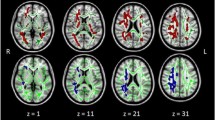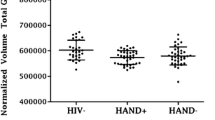Abstract
Fatigue is among the most common symptoms reported by HIV-infected individuals. Previous reports suggest that the prevalence of fatigue varies by disease status with rates close to 80% in patients with AIDS. However, most studies have not been conducted in the setting of a controlled trial and have not assessed the association of fatigue with cellular markers of brain activity. Data for this study were derived from baseline and longitudinal evaluations in ACTG A5090, a randomized, double-blind, placebo-controlled trial of the Selegiline Transdermal System for the treatment of HIV-associated cognitive impairment. Fatigue was assessed using the Fatigue Severity Scale with scores of >4 considered “fatigued”. Participants in a substudy underwent brain magnetic resonance spectroscopy (MRS) imaging, an in vivo method for assessing brain metabolites associated with neuronal and glia activity. Differences between fatigued and non-fatigued participants were evaluated with respect to demographics and clinical characteristics, plasma and CSF HIV-1 RNA concentration, CD4 counts, and brain metabolites. One hundred and twenty-eight participants were enrolled (88% male, median age = 45 years) and 82 participants (64%, 95% confidence interval 55%, 72%) were fatigued at baseline. MRS was conducted in 62 of the 128 participants. Fatigued participants were significantly younger (p = 0.011), had lower Karnofsky scores (p = 0.032), and had higher levels of depressive symptoms on the Center for Epidemiologic Studies Depression (CES-D) scale (p < 0.001) than non-fatigued participants. Statistically significant differences between fatigued and non-fatigued groups were not detected for plasma and CSF HIV-1RNA concentration, CD4 counts, or on neuropsychological tests. MRS revealed significantly lower levels of the cellular energy marker total creatine (p = 0.002) in the basal ganglia of fatigued participants. Statistically significant differences in other brain metabolites were not detected. Longitudinal data showed that fatigue persisted and worse fatigue at baseline was predictor of future fatigue. Among the cognitive tests, baseline Stroop score was associated with future fatigue. Fatigue was present in 64% of A5090 study participants and persisted during the 24 weeks of follow-up. Fatigue was associated with worse functional performance and depressive mood. Lower cellular energy levels in the basal ganglia, as measured by MRS total creatine concentration, suggest energy dysmetabolism in this brain region. This observation, taken together with the association between fatigue and neuropsychological tests of frontal lobe performance is consistent with the hypothesis of a striatal–cortical circuitry involvement in the symptoms of fatigue.
Similar content being viewed by others
References
Breitbart W, McDonald MV, Rosenfeld B, Monkman ND, Passik S (1998) Fatigue in ambulatory AIDS patients. J Pain Symptom Manage 15:159–167
Brinkman K, Smeitink JA, Romijn JA, Reiss P (1999) Mitochondrial toxicity induced by nucleoside-analogue reverse-transcriptase inhibitors is a key factor in the pathogenesis of antiretroviral-therapy-related lipodystrophy. Lancet 354:1112–1115
Capuron L, Pagnoni G, Demetrashvili MF et al (2007) Basal ganglia hypermetabolism and symptoms of fatigue during interferon-alpha therapy. Neuropsychopharmacology 32:2384–2392
Carr A, Cooper DA (2000) Adverse effects of antiretroviral therapy. Lancet 356:1423–1430
Carr A, Miller J, Law M, Cooper DA (2000) A syndrome of lipoatrophy, lactic acidaemia and liver dysfunction associated with HIV nucleoside analogue therapy: contribution to protease inhibitor-related lipodystrophy syndrome. AIDS 14:F25–F32
Chang L, Ernst T, Witt MD, Ames N, Gaiefsky M, Miller E (2002) Relationships among brain metabolites, cognitive function, and viral loads in antiretroviral-naive HIV patients. Neuroimage 17:1638–1648
Chaudhuri A, Behan PO (2000) Fatigue and basal ganglia. J Neurol Sci 179:34–42
Cleary PD, Fowler FJ, Weissman J et al (1993) Health-related quality of life in persons with Acquired Immune Deficiency Syndrome. Med Care 31:569–580
Clifford DB, McArthur JC, Schifitto G et al (2002) A randomized clinical trial of CPI-1189 for HIV-associated cognitive-motor impairment. Neurology 59:1568–1573
Collado-Hidalgo A, Bower JE, Ganz PA, Cole SW, Irwin MR (2006) Inflammatory biomarkers for persistent fatigue in breast cancer survivors. Clin Cancer Res 12:2759–2766
Cote HCF, Brumme ZL, Craib KJP et al (2002) Changes in mitochondrial DNA as a marker of nucleoside toxicity in HIV-infected patients. N Engl J Med 346:811–820
Dalakas MC, Semino-Mora C, Leon-Monzon M (2001) Mitochondrial alterations with mitochondrial DNA depletion in the nerves of AIDS patients with peripheral neuropathy induced by 2'3'-dideoxycytidine (ddC). Lab Invest 81:1537–1544
Darko DF, McCutchan JA, Kripke DF, Gillin JC, Golshan S (1992) Fatigue, sleep disturbance, disability, and indices of progression of HIV infection. Am J Psychiatry 149:514–520
Delgado J, Harris M, Tesiorowski A, Montaner JS (2001) Symptomatic elevations of lactic acid and their response to treatment manipulation in human immunodeficiency virus-infected persons: a case series. Clin Infect Dis 33:2072–2074
Deluca J, Genova HM, Hillary FG, Wylie G (2008) Neural correlates of cognitive fatigue in multiple sclerosis using functional MRI. J Neurol Sci 270(1–2):28–39
Duran S, Spire B, Raffi F et al (2001) Self-reported symptoms after initiation of a protease inhibitor in HIV-infected patients and their impact on adherence to HAART. HIV Clin Trials 2:38–45
Ferrando S, Evans S, Goggin K, Sewell M, Fishman B, Rabkin J (1998) Fatigue in HIV illness: relationship to depression, physical limitations, and disability. Psychosom Med 60:759–764
Heesen C, Nawrath L, Reich C, Bauer N, Schulz KH, Gold SM (2006) Fatigue in multiple sclerosis: an example of cytokine mediated sickness behaviour? J Neurol Neurosurg Psychiatry 77:34–39
Herlofson K, Larsen JP (2003) The influence of fatigue on health-related quality of life in patients with Parkinson's disease. Acta Neurol Scand 107:1–6
Jones G, Power C (2006) Regulation of neural cell survival by HIV-1 infection. Neurobiol Dis 21:1–17
Justice AC, Rabeneck L, Hays RD, Wu AW, Bozzette SA (1999) Sensitivity, specificity, reliability, and clinical validity of provider-reported symptoms: a comparison with self-reported symptoms. Outcomes Committee of the AIDS Clinical Trials Group. J Acquir Immune Defic Syndr 21:126–133
Kakuda TN, Brundage RC, Anderson PL, Fletcher CV (1999) Nucleoside reverse transcriptase inhibitor-induced mitochondrial toxicity as an etiology for lipodystrophy. AIDS 13:2311–2312
Kim MJ, Leclercq P, Lanoy E et al (2007) A 6-month interruption of antiretroviral therapy improves adipose tissue function in HIV-infected patients: the ANRS EP29 Lipostop Study. Antivir Ther 12:1273–1283
Kleinman L, Zodet MW, Hakim Z et al (2000) Psychometric evaluation of the fatigue severity scale for use in chronic hepatitis C. Qual Life Res 9:499–508
Kos D, Kerckhofs E, Nagels G, D'hooghe MB, Ilsbroukx S (2008) Origin of fatigue in multiple sclerosis: review of the literature. Neurorehabil Neural Repair 22:91–100
Kreis R, Ernst T, Ross BD (1993) Absolute quantitation of water and metabolites in the human brain. II. Metabolite concentrations. J Magn Reson B 102:9–19
Krupp LB, LaRocca NG, Muir-Nash J, Steinberg AD (1989) The fatigue severity scale. Application to patients with multiple sclerosis and systemic lupus erythematosus. Arch Neurol 46:1121–1123
Lyketsos CG, Hoover DR, Guccione M et al (1996) Changes in depressive symptoms as AIDS develops. The Multicenter AIDS Cohort Study. Am J Psychiatry 153:1430–1437
McArthur JC, McDermott MP, McClernon D et al (2004) Attenuated central nervous system infection in advanced HIV/AIDS with combination antiretroviral therapy.[Erratum appears in Arch Neurol. 2005 Jul;62(7):1110]. Arch Neurol 61:1687–1696
McElhiney M, Rabkin J, Van Gorp W, Rabkin R (2009) Modafinil effects on cognitive function in HIVpatients treated for fatigue: a placebo controlled study. J Clin Exp Neuropsychol 32(5):474–480
Millikin CP, Rourke SB, Halman MH, Power C (2003) Fatigue in HIV/AIDS is associated with depression and subjective neurocognitive complaints but not neuropsychological functioning. J Clin Exp Neuropsychol 25:201–215
Molassiotis A, Nahas-Lopez V, Chung WY, Lam SW, Li CK, Lau TF (2002) Factors associated with adherence to antiretroviral medication in HIV-infected patients. Int J STD AIDS 13:301–310
Navia BA, Cho E-S, Petito CK, Price RW (1986) The AIDS dementia complex: II. Neuropathology. Ann Neurol 19:525–535
Perkins DO, Leserman J, Stern RA et al (1995) Somatic symptoms and HIV infection: relationship to depressive symptoms and indicators of HIV disease. Am J Psychiatry 152:1776–1781
Phillips KD, Sowell RL, Rojas M, Tavakoli A, Fulk LJ, Hand GA (2004) Physiological and psychological correlates of fatigue in HIV disease. Biol Res Nurs 6:59–74
Rabkin JG, McElhiney MC, Rabkin R, Ferrando SJ (2004) Modafinil treatment for fatigue in HIV+ patients: a pilot study. J Clin Psychiatry 65:1688–1695
Rabkin JG, McElhiney MC, Rabkin R, McGrath PJ (2010) Modafinil treatment for fatigue in HIV/AIDS: a randomized placebo-controlled study. J Clin Psychiatry 71(6):707–15
Roelcke U, Kappos L, Lechner-Scott J et al (1997) Reduced glucose metabolism in the frontal cortex and basal ganglia of multiple sclerosis patients with fatigue: a 18 F-fluorodeoxyglucose positron emission tomography study. Neurology 48:1566–1571
Schifitto GM, McDermott MPP, McArthur JCM et al (2005) Markers of immune activation and viral load in HIV-associated sensory neuropathy. Neurology 64:842–848
Schifitto G, Zhang J, Evans SR et al (2007) A multicenter trial of selegiline transdermal system for HIV-associated cognitive impairment. Neurology 69:1314–1321
Schifitto G, Friedman JH, Oakes D et al (2008) Fatigue in levodopa-naive subjects with Parkinson disease. Neurology 71:481–485
Schifitto G, Yiannoutsos CT, Ernst T et al (2009) Selegiline and oxidative stress in HIV-associated cognitive impairment. Neurology 73:1975–1981
Shulman LM, Taback RL, Bean J, Weiner WJ (2001) Comorbidity of the nonmotor symptoms of Parkinson's disease. Mov Disord 16:507–510
Silverberg MJ, Gore ME, French AL et al (2004) Prevalence of clinical symptoms associated with highly active antiretroviral therapy in the Women's Interagency HIV Study. Clin Infect Dis 39:717–724
Sullivan PS, Dworkin MS (2003) Prevalence and correlates of fatigue among persons with HIV infection. J Pain Symptom Manage 25:329–333
Voss JG (2005) Predictors and correlates of fatigue in HIV/AIDS. J Pain Symptom Manage 29:173–184
Wilson IB, Cleary PD (1996) Clinical predictors of functioning in persons with Acquired Immunodeficiency Syndrome. Med Care 34:610–623
Witjas T, Kaphan E, Azulay JP et al (2002) Nonmotor fluctuations in Parkinson's disease: frequent and disabling. Neurology 59:408–413
Acknowledgements
The study was supported by the AIDS Clinical Trials Group funded by the National Institute of Allergy and Infectious Diseases grants AI38858, AI68636, AI68634, AI069465, AI-069511-02, AI 069434, AI 69432, AI27660, the Neurologic AIDS Research Consortium funded by the National Institute of Neurologic Diseases and Stroke, NS32228, the General Clinical Research Center Units funded by the National Center for Research Resources grants RR025005, 5-MO1 RR00044, UO1-AI 032783-14, and by the National Institute of Mental Health MH64409.
From University of California, San Diego: R. Ellis; K. Nuffer, S. Cahill;
Johns Hopkins University: N. Sacktor; D. Burgess, K. Carter;
University of Rochester: M. Shoemaker, A. Weisbeck; University of Hawaii: V. Valcour; L. Chang; N. Hanks, M. Watters;
UCLA CARE Center: E. Singer, E. Miller; S. Chafey;
University of Washington, Seattle: C. Marra; S. Dunaway, M. Perrin;
University of Pennsylvania, Philadelphia: D. Kolson;
Harvard/Massachusetts General Hospital: N. Venna; T. Flynn;
Washington University, St. Louis: T. Spitz, M. Gould;
Northwestern University: B. Cohen, L. Reisberg;
University of Texas, Southwestern Med Ctr: R. Diaz-Arrastia, C. Lohner;
Columbia University: K. Marder, R. Clouse;
Mount Sinai Medical Center; Beth Israel Medical Center: D. Simpson; D. Mildvan, J. Bailey;
Miriam Hospital: K. Tashima, H. Sousa;
University of North Carolina: D. Currin, S. Pedersen.
Disclosure
The authors report no conflicts of interest.
Statistical analyses conducted by Lijuan Deng, Tzu-min Yeh, and Scott R. Evans.
Author information
Authors and Affiliations
Corresponding author
Rights and permissions
About this article
Cite this article
Schifitto, G., Deng, L., Yeh, Tm. et al. Clinical, laboratory, and neuroimaging characteristics of fatigue in HIV-infected individuals. J. Neurovirol. 17, 17–25 (2011). https://doi.org/10.1007/s13365-010-0010-5
Received:
Revised:
Accepted:
Published:
Issue Date:
DOI: https://doi.org/10.1007/s13365-010-0010-5




